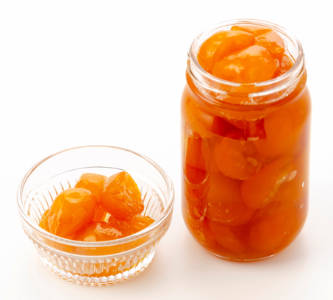Accompaniments Category

Includes condiments, pickles, and olives
Kalamata olives
You can find these popular Greek black olives in most large supermarkets. They're salty and have a rich, fruity flavor. These can be eaten out of hand, or used to make tapenades.
Learn morekecap manis
This thick, dark sauce is the Indonesian ancester of ketchup. Look for it in Indonesian markets.
Learn moreketchup
Ketchup is a common condiment especially in America. It is made with tomatoes, sugar, vinegar and spices.
Learn morekim chee
This Korean specialty is made with cabbage, vinegar, garlic, and hot chile peppers, all of which are put into jars and allowed to ferment. It's spicy and very good.
Learn morelemon marmalade
This is made by boiling the fruit and peel of lemons with sugar, pectin, and water. It manages to be bitter, sour, and sweet all at once, which many people find delightful.
Learn morelighter Bake
This is a mixture of pureed prunes and apples that serves as a fat substitute in baking.
Learn morelotus leaves
These leaves open up like butterfly wings, each about two feet high. They're often wrapped around rice and other fillings, to which they impart an earthy aroma when the bundles are steamed. The leaves are available either fresh or, more commonly, dried in Asian markets. Soak them for at least an hour in warm water before using, and keep fresh leaves in a cool, dry place or else freeze them.
Learn moremaguey leaves
These leaves have been used to wrap meat for flavor and to tenderize while cooking.
Learn moreManzanilla olives
These green olives are available in most supermarkets. They're often pitted and stuffed with pimento or garlic. They're often put into martinis.
Learn moremaraschino cherry
These sugar-soaked and dyed cherries come in two colors: red (almond flavored) or green (mint flavored). Cooks usually use them to garnish desserts and drinks.
Learn moremincemeat
Mincemeat is made with dried fruit, nuts, citrus peel, spices, and sometimes brandy, rum, or some other liquor. It used to be made with meat as well, and ready-made jars of it sometimes contain beef suet. It's often used for holiday pies.
Learn moreMission olives
These are the common black ones that are ubiquitous in supermarkets, pizza parlors, and salad bars. They don't have as much character as European black olives.
Learn moreMoroccan dry-cured olives
These are shriveled black olives that are somewhat bitter. They're best used for cooking rather than snacking.
Learn moremuscadine jelly
Made from muscadine grapes, this is a redder, tarter version of grape jelly.
Learn morenam prik pao
This paste is made from chilies, onions, sugar, shrimp paste, fish sauce, and sometimes tamarind. It's sold in jars, and comes in different strengths, ranging from hot to mild.
Learn more
































































































































































































































































































































































